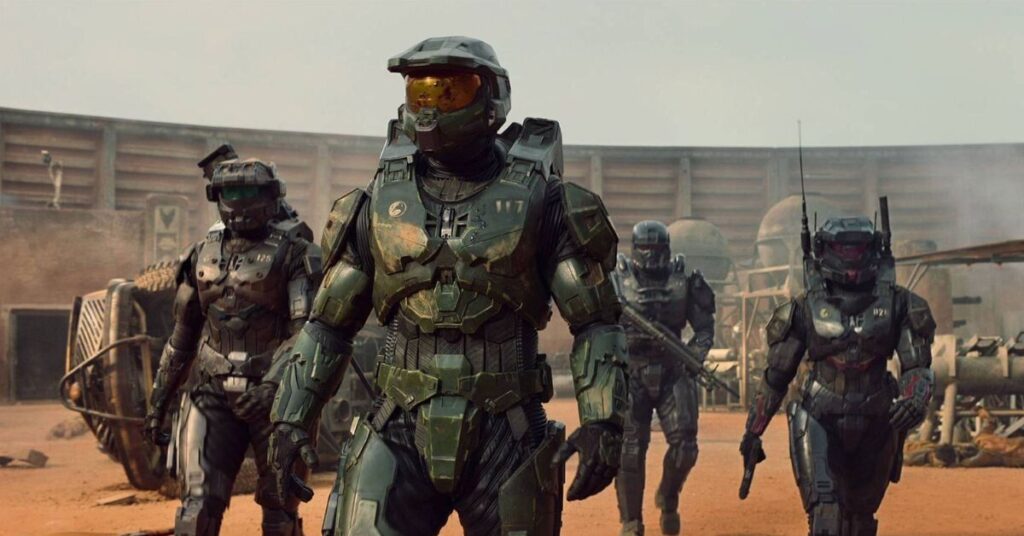Halo: Combat Evolved revolutionized the gaming industry. It was released in 2001 for Xbox. The PC version followed in 2003. Halo’s impact on first-person shooters was immense. Its visual identity became iconic.
The game’s user interface elements left a lasting impression. Gamers and designers still reference Halo’s aesthetic today.
The Birth of an Icon
Bungie Studios created Halo. They wanted a unique sci-fi universe. The game needed to stand out visually. Halo’s art direction was crucial. It blended futuristic and military elements. The result was instantly recognizable. Halo’s visual language extended beyond character designs. It encompassed every aspect of the game’s interface.
The Importance of Game Icons
Game icons serve multiple purposes. They provide quick information to players. Icons represent weapons, items, and game states. Effective icons enhance gameplay flow. They reduce the need for text explanations.
In fast-paced games, clear icons are essential. Halo’s icons became a benchmark in the industry.
Halo’s Iconic Design Elements
The Energy Shield
Halo introduced the recharging shield mechanic. The shield icon was simple yet effective. It was a curved bar at the top of the screen. Players could quickly gauge their shield status. This design influenced many future games.
Weapon Icons
Halo’s weapon icons were distinctive. Each weapon had a unique silhouette. Players could identify weapons at a glance.
The assault rifle icon became particularly famous. It represented Halo in many marketing materials.
The Motion Tracker
The motion tracker was a circular radar. It showed enemy positions relative to the player. Its design was both functional and aesthetically pleasing. The tracker became a staple of the Halo series.
The Crosshair
Halo’s crosshair was simple but effective. It changed based on the equipped weapon. The design provided feedback without cluttering the screen. Many games adopted similar dynamic crosshairs.
Health Bar
The health bar complemented the shield system. It was visible only when the shield was depleted. This two-tier health system became a Halo trademark. The health icon was a simple red cross.
The Color Palette
Halo’s UI used a distinctive color scheme. Blue represented allies and shields. Red indicated enemies and damage. Yellow showed neutral elements. This color coding became intuitive for players. It allowed for quick information processing during gameplay.
Typography in Halo

Halo’s font choices were deliberate. The game used a clean, futuristic typeface. Menu text was easy to read. In-game text was minimal but impactful. The typography reinforced the sci-fi aesthetic.
HUD Layout
Halo’s heads-up display (HUD) was groundbreaking. It provided essential information without overwhelming players.
The layout was clean and intuitive. Weapon info, shields, and radar were all easily visible. This design influenced FPS games for years to come.
Menu Design
Halo’s menu screens were sleek and futuristic. They used a blue and black color scheme. The main menu featured the iconic Halo ring. Menu navigation was smooth and intuitive. The design set a new standard for console game interfaces.
Loading Screens
Even Halo’s loading screens were iconic. They featured the Halo logo and a progress bar. The design was simple yet memorable. It built anticipation for the gameplay to come.
Multiplayer Icons
Halo’s multiplayer mode had its own set of icons. Team colors were clearly displayed. Player status icons were easy to understand. The scoreboard design was clean and informative. These elements enhanced the multiplayer experience.
The Impact on Gaming Culture
Halo’s visual elements became cultural touchstones. The energy sword icon was instantly recognizable. Cosplayers recreated the MJOLNIR armor in detail. Fan art often featured Halo’s iconic weapons and symbols. The game’s aesthetic influenced sci-fi media beyond gaming.
Evolution Through the Series
Subsequent Halo games built on the original’s design. Halo 2 refined the UI elements. Halo 3 introduced equipment icons.
Each game respected the established visual language. The core design principles remained consistent. This consistency helped build the Halo brand.
Influence on Other Games

Many games adopted elements of Halo’s UI design. The two-tier health system became common in FPS games. Dynamic crosshairs are now industry standard. The clean, informative HUD influenced countless titles. Halo’s impact on game UI design is undeniable.
The Technical Achievement
Halo’s UI was not just aesthetically pleasing. It was also technically impressive for its time. The game maintained a smooth framerate. UI elements never hindered performance. This technical prowess set a new bar for console games.
Design Philosophy
Bungie’s design philosophy prioritized clarity. Every UI element had a purpose. Nothing was superfluous. This approach influenced game design broadly. It showed that less could indeed be more in UI design.
The Role of Sound
Audio cues complemented the visual icons. Shield recharge had a distinct sound. Different weapons had unique audio signatures. This audio-visual synergy enhanced the user experience. It became a hallmark of the Halo series.
Marketing and Branding
Halo’s icons played a crucial role in marketing. The game’s logo became instantly recognizable. Weapon icons appeared on merchandise.
The visual language of Halo extended beyond the game itself. It became a powerful branding tool for Microsoft.
Read This Blog: Aeonscope Video Gaming: An Extensive Information Investigation
Community Creation
Halo’s iconic elements inspired fan creations. Players made custom emblems for multiplayer. Fan sites used Halo’s visual language. Modders recreated Halo’s UI in other games. The community embraced and expanded on the game’s aesthetic.
Critical Reception
Critics praised Halo’s UI design. Reviews often mentioned the clean interface. The game won numerous design awards. Its visual style was considered groundbreaking. Halo set a new standard for console FPS games.
Legacy in Game Design Education
Game design courses often reference Halo. It’s used as a case study in UI design. Students analyze its effective use of icons. The game demonstrates principles of clear visual communication. Halo’s influence extends to the education of new designers.
Challenges and Criticisms
Not all of Halo’s design choices were universally praised. Some found the HUD too minimalistic. Others criticized the lack of a traditional health bar. The game’s sequels addressed some of these concerns. This demonstrates the iterative nature of game design.
Adaptation to High Definition
The transition to HD gaming presented challenges. Halo 3 had to adapt its icons for higher resolutions. The core designs remained recognizable. This showed the strength of the original visual concepts. They scaled well to new display technologies.
Comparisons to Contemporary Games
Halo’s UI stood out among its peers. Many FPS games of the era had cluttered interfaces. Halo proved that simplicity could be powerful. It influenced a trend towards cleaner UI design in games. This impact is still felt in modern game development.
The Role of Testing
Bungie extensively tested Halo’s UI. They refined icons based on player feedback. This iterative process was crucial. It ensured that the final design was both aesthetic and functional. The attention to detail paid off in the final product.
Accessibility Considerations
Halo’s clear icons aided accessibility. Colorblind players could still distinguish UI elements. The simple designs were easy to see in various lighting conditions. This focus on accessibility was ahead of its time. It’s now a major consideration in game design.
Balancing Aesthetics and Function
Halo’s designers walked a fine line. They created visually appealing icons. But function always came first. This balance was key to the game’s success. It showed that game UI could be both beautiful and practical.
The Importance of Consistency
Halo maintained visual consistency throughout. Icons in menus matched those in gameplay. This consistency aided player learning. It made the game more intuitive overall. Many games now strive for similar visual coherence.
Localization Challenges
Halo’s iconic design faced localization challenges. Icons needed to work across languages. The designers created culturally neutral symbols where possible. This foresight helped Halo succeed globally. It’s now a consideration in international game design.
The Halo Ring as a Central Motif
The Halo ring itself became an iconic symbol. It appeared in loading screens and menus. The ring shape influenced other UI elements. This central motif tied the game’s visuals together. It’s an example of cohesive design in gaming.
Merchandise and Beyond
Halo’s icons transcended the game. They appeared on t-shirts and posters. Action figures featured iconic weapons. The visual language entered pop culture. This expanded Halo from a game to a media franchise.
Remastered Editions
Halo: Combat Evolved Anniversary updated the graphics. The remaster respected the original designs. Icons were enhanced but remained recognizable. This demonstrated the timeless quality of the original art. It also showed how to modernize classic designs respectfully.
Read This Blog: Speak with A Gravelly Voice NYT
Influence on Xbox Design
Halo’s success influenced Xbox as a platform. The console’s UI took cues from the game. Green became Xbox’s signature color. This shows how a game can shape a entire gaming ecosystem. Halo’s design legacy extends beyond just games.
The Human Element
Despite its futuristic setting, Halo’s design felt human. The icons were relatable and intuitive. This human touch made the game accessible. It’s a lesson in designing for user experience. The best designs connect with users on a personal level.
Collector’s Editions
Special editions of Halo featured unique designs. Steelbook cases showcased iconic imagery. Collectors treasured these visual artifacts. This showed the emotional connection players had with Halo’s aesthetic. It turned game design into collectible art.
Digital vs. Physical Design
Halo’s icons worked both digitally and physically. They looked good on screen and in print. This versatility was key to the franchise’s branding. Modern games still strive for this adaptability in design. Halo set the standard for cross-media visual identity.
The Role of Concept Art
Concept art was crucial in developing Halo’s look. Artists explored various styles for icons and UI. This process refined the game’s visual language. Many of these concept pieces are now treasured by fans. They offer insight into the design process.
Easter Eggs and Hidden Details
Halo’s UI contained subtle easter eggs. Keen-eyed players discovered hidden symbols. These details added depth to the game world. They rewarded attentive players. This practice of hiding details in UI became common in games.
The Soundtrack’s Visual Representation
Even Halo’s music had visual representations. The soundtrack menu used unique icons. These blended with the overall UI design. It showed how visual design can extend to all aspects of a game. The cohesion between audio and visuals was noteworthy.
Film and TV Adaptations
Halo’s visual language influenced its adaptations. The Halo TV series referenced iconic designs. Movies and anime used familiar symbols. This showed the strength of Halo’s visual brand. It translated well across different media.
Esports and Streaming

As Halo became an esports title, its UI gained new importance. Streaming overlays incorporated Halo’s designs. Esports teams created logos inspired by the game. This demonstrates how game UI can impact competitive gaming. Halo’s clear visual language was an asset in fast-paced tournaments.
Virtual Reality Considerations
The advent of VR presented new challenges. Designers had to rethink how Halo’s UI would work in 3D space. This ongoing process shows how classic designs adapt to new technologies. Halo’s enduring aesthetic continues to evolve.
Fostering Community Engagement
Halo’s distinctive look fostered community engagement. Fans created custom emblems and armor designs. This personalization became a key feature. It showed how game design could encourage player creativity. Many games now include similar customization options.
The Psychology of Color in Halo
Halo’s color choices were psychologically informed. Blue for allies created a sense of trust. Red for enemies triggered alertness. This use of color psychology enhanced gameplay. It’s now a common consideration in game design.
Minimalism Before It Was Trendy
Halo embraced minimalism in UI design. This was before the trend became widespread. The game proved that less could be more. This principle influenced UI design across industries. Halo was ahead of its time in this regard.
The Importance of Silhouettes
Halo’s designers paid close attention to silhouettes. Each weapon and character had a distinct outline. This made identification quick and easy. The practice is now standard in character and object design. Halo showed the power of a strong silhouette.
Balancing Detail and Clarity
Halo struck a balance between detail and clarity. Icons were detailed enough to be interesting. But they remained clear at a glance. This balance is crucial in fast-paced gameplay. Many games struggle to achieve this equilibrium.
The Role of Negative Space
Halo’s UI made effective use of negative space. The HUD didn’t crowd the screen. This gave players a clear view of the action. The use of space became a design principle. It showed that what’s not there is as important as what is.
Evolving with Technology
As graphics improved, Halo’s icons evolved. They became more detailed in later games. Yet they retained their core identity. This evolution shows how to update designs for new hardware. It’s a lesson in maintaining brand identity across generations.
Inspiring Fan Art
Halo’s iconic designs inspired countless fan artists. Players created their own versions of weapons and characters. This engagement extended the life of the franchise. It showed how strong visual design can create a lasting community.
The Importance of First Impressions
Halo’s title screen made a strong first impression. The iconic logo and music set the tone. This attention to initial presentation became industry standard. Halo showed that every element, even a title screen, matters.
Designing for Emotional Impact
Halo’s UI wasn’t just functional; it was emotional. The shield depletion effect created tension. Scoring multi-kills felt rewarding visually.
This emotional design enhanced player engagement. It’s now a key consideration in game UI design.
The Legacy Continues
New Halo games continue to reference the original designs. This creates a sense of nostalgia and continuity. It shows the lasting impact of the original game. Halo’s visual legacy is still shaping games today.
Frequently Asked Questions
What made Halo’s UI design revolutionary?
Halo’s UI combined simplicity, functionality, and style. It provided essential information without cluttering the screen. The design enhanced immersion and gameplay flow.
How did Halo influence other FPS games?
Halo popularized features like regenerating shields and two-weapon systems. Its clean HUD design and intuitive icons set new standards for the genre.
Why are Halo’s weapon icons so recognizable?
Halo’s weapon icons used distinctive silhouettes and colors. They were designed to be instantly identifiable during fast-paced gameplay.
How has Halo’s UI evolved over the series?
While maintaining core elements, Halo’s UI has adapted to new technologies. Each game refines and builds upon the original design principles.
What role did sound play in Halo’s UI design?
Sound cues complemented visual elements, enhancing the user experience. Audio feedback for shields, weapons, and events became signature features.
Conclusion
Halo (2003) Game Icons Banners left an indelible mark on gaming history. The game’s visual design transcended mere functionality. It became a cultural touchstone. Halo’s influence extends far beyond its own franchise.
It shaped the entire FPS genre. The principles established in Halo continue to influence game design today. As technology advances, Halo’s legacy adapts and endures. It remains a testament to the power of thoughtful, iconic design in gaming.

I’m Shoaib, a passionate blogger with 5 years of experience. I love writing about tech. My goal is to share useful information and insights with you. Explore my website to discover exciting content on various topics!



